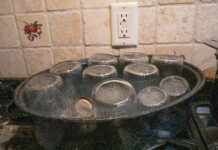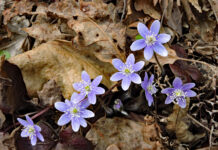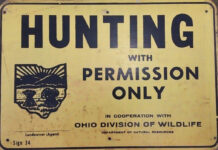By Kellie Docherty
Winter is here, which means snow and slippery conditions. To keep communities safe, municipalities use salt to keep roadways clear for transportation. While road salt is an important tool, it can become an issue for our waterways, wildlife and infrastructure when used irresponsibly.
Using road salt is crucial for reducing the risks of accidents, and this can be achieved while still minimizing excess salt runoff into our waterways. Remember the acronym S.A.L.T. this winter to ensure your safety while keeping excess salt from streams.
Stuff: Road salt (sodium chloride) becomes less effective when used under 15°F. When temperatures drop to those extreme lows, use some sand to help add some additional traction in slippery areas or switch to a de-icing substance that works in colder temperatures.
Amount: More salt is not inherently better. It is more cost-effective and safer for our waterways when you use the recommended amount. A 12-oz coffee mug is enough to cover 120 square feet or 10 sidewalk squares. There should be approximately three inches between the salt granules. If you see any excess salt on the ground after the ice is gone and temperatures rise above freezing, be sure to sweep up any leftover salt to use for later.
Location: Salt should be used on sidewalks, driveways or any other surfaces on which you wish to prevent ice from forming (asphalt or concrete). Never spread salt on gardens or around trees, especially near storm drains or streams.
Time: To get the most out of your salt, timing on when to use it is very important. Road salt should be spread right before snowfall or after removing snow. If rain is in the forecast, avoid using salt so that it doesn’t wash down the storm drain and enter our waterways.
Though salt is important to keep us safe in the winter, it is important to only use what you need to prevent excess salt from entering our freshwater resources. Once that salt enters our waterways, it becomes very difficult and costly to remove.
The U.S. applies 20 million metric tons of salt per year to roadways in states that get cold icy weather in the winter. Just like people, nature also has a threshold on how much salt it can take before a decrease in health. High salinity levels in our freshwater resources can kill off algae-eating zooplankton. As its name suggests, this organism helps keep algae levels low.
When excess salt kills these zooplankton, algal blooms can go unchecked and add additional issues to our lakes, ponds, and drinking water. Salinity levels don’t need to be at an extreme to cause issues, though. Fish living in streams with non-lethal levels of salinity are found to have reduced growth, which isn’t great for anyone trying to catch a big fish.
When fish living in these streams reach adulthood, they’re also found to have impaired reproduction, leading to a decrease in fish populations.
Using road salt is an important tool to keep our roadways clear, and it is critical to only use what we need and not spread too much. By implementing best practices, public agencies, private businesses and the public can help prevent excess salt use and help keep our freshwater resources salt-free. Remember, a little goes a long way.
Interested in learning more? Winter Salt Awareness Week is Jan. 27-31. Visit WinterSaltWeek.org for a series of webinars providing education about how salt affects our streams and what professionals and community members can do to help our waterways.
(Kellie Docherty is the education coordinator with Medina Soil and Water Conservation District. To contact the district, call 330-722-9322.)













